
Let's dive into one of the most fundamental movements in strength training: the hip hinge.
Section 1: Importance of the Hip Hinge
The hip hinge is a crucial movement pattern that forms the foundation for exercises like deadlifts, kettlebell swings, and bent-over rows. Mastering the hip hinge not only helps you lift more efficiently but also protects your lower back from injury and enhances overall athletic performance.
Section 2: What is a Hip Hinge?
So, what exactly is a hip hinge? A hip hinge is a movement where you bend at your hips while keeping your spine neutral and your knees slightly bent. The key here is to hinge from your hips, not your lower back.
Section 3: Step-by-Step Guide
Let’s break down the hip hinge step-by-step.
1. Starting Position: - Stand with your feet hip-width apart. - Keep a slight bend in your knees. - Engage your core and keep your chest up.
2. Hip Hinge Movement: - Push your hips back as if you’re trying to touch an invisible wall behind you. - Keep your spine neutral—no rounding or arching. - Your upper body will naturally tilt forward as your hips move back. - Keep the movement controlled and smooth.
3. Weight Distribution: - Keep the weight on your heels and midfoot, not your toes. - You should feel a stretch in your hamstrings as your hips move back.
4. Return to Standing: - Once your upper body is parallel to the ground or you feel a stretch in your hamstrings, drive your hips forward to return to the starting position. - Squeeze your glutes at the top to fully extend your hips.
Section 4: Common Mistakes
Now, let’s talk about some common mistakes to avoid:
1. Rounding the Back: - Keep your spine neutral throughout the movement to avoid putting stress on your lower back.
2. Knee Dominance: - Remember, this is a hip-dominant movement. Don’t let your knees bend too much or push forward.
3. Weight on Toes: - Maintain your weight on your heels and midfoot to ensure proper balance and activation of the posterior chain.
Section 5: Practice and Progression
Practice makes perfect! Start with bodyweight hip hinges to get the movement pattern down. Once you’re comfortable, you can progress to using a dowel or broomstick along your spine to ensure proper alignment. From there, you can incorporate light weights like dumbbells or kettlebells before advancing to heavier lifts like the deadlift.
Conclusion
And there you have it—a complete guide to mastering the hip hinge!
Remember, the key is to hinge from your hips, keep your spine neutral, and practice regularly.
If you found this article and video helpful, give it a thumbs up, like, and subscribe to our channel for more fitness tips, and hit that notification bell so you never miss an update.
Coach Rob
How To Correctly Do A Hip-Hinge

0 comments